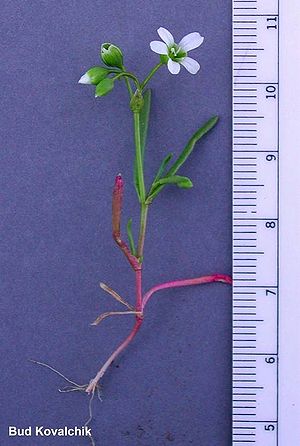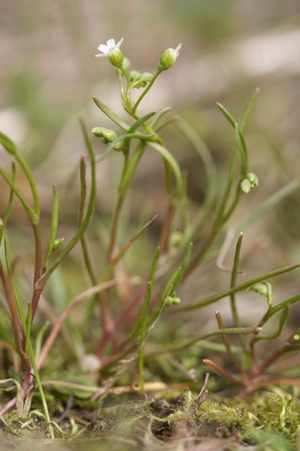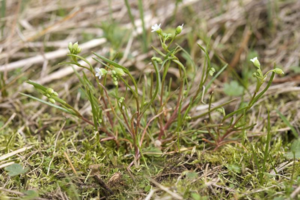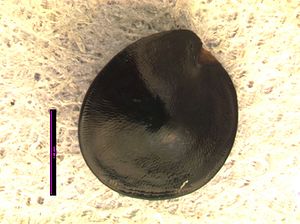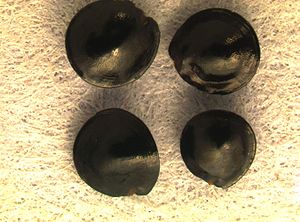Difference between revisions of "Montia linearis"
| Line 27: | Line 27: | ||
==Description== | ==Description== | ||
General: Annual herb from a fibrous root; stems ascending to erect, usually solitary but sometimes several, branched or unbranched, 5-20 cm tall. | General: Annual herb from a fibrous root; stems ascending to erect, usually solitary but sometimes several, branched or unbranched, 5-20 cm tall. | ||
| − | |||
| − | |||
| − | |||
| + | Leaves: Basal leaves lacking; stem leaves several, leaves are alternate and narrow, 1.5 - 5 cm long. linear, 1-3 mm wide. | ||
| − | + | Flowers: Inflorescence of loose terminal or axillary racemes 2-5 cm long with 5-12 flowers on slightly recurved stalks 5-20 mm long; petals 5, white, 4-6.5 mm long; sepals 2, 3-4 mm long but up to 6 mm long in fruit; stamens 3. | |
| − | + | ||
| − | + | ||
| + | Fruits: Capsules, 3-valved; seeds black, shiny, lens-shaped, 1.4-2.5 mm long | ||
==Bloom Period== | ==Bloom Period== | ||
April - July | April - July | ||
| Line 42: | Line 39: | ||
==Distribution== | ==Distribution== | ||
| − | + | From British Columbia, east to Saskatchewan, south along the west coast of the United States to Southern California, and is also present in some states in the south eastern United States. | |
<ref name=The PLANTS Database>USDA, NRCS. 2012. The PLANTS Database (http://plants.usda.gov, 16 April 2012). National Plant Data Team, Greensboro, NC 27401-4901 USA. </ref> | <ref name=The PLANTS Database>USDA, NRCS. 2012. The PLANTS Database (http://plants.usda.gov, 16 April 2012). National Plant Data Team, Greensboro, NC 27401-4901 USA. </ref> | ||
| Line 56: | Line 53: | ||
Flats were removed from the cooler after 2 weeks and placed in greenhouse set at moderate temperatures (70 degree days/ 50 degree nights.) | Flats were removed from the cooler after 2 weeks and placed in greenhouse set at moderate temperatures (70 degree days/ 50 degree nights.) | ||
Seeds germinated within one to two weeks. 60% germination occurred. | Seeds germinated within one to two weeks. 60% germination occurred. | ||
| − | |||
| − | |||
| − | |||
| − | |||
===Seed=== | ===Seed=== | ||
| − | |||
| − | |||
'''Seed sample from:''' 2011 | '''Seed sample from:''' 2011 | ||
| Line 88: | Line 79: | ||
{{Basics}} | {{Basics}} | ||
| + | |||
| + | |||
| + | ==Photo Gallery== | ||
| + | |||
==References== | ==References== | ||
<References/> | <References/> | ||
Revision as of 14:37, 27 May 2012
Common name: narrow-leaved montia, narrowleaf miner's lettuce, or narrow leaved water chickweed.
Abbreviation Code (Codon): MOLI
Synonyms: Claytonia linearis, Montiastrum lineare
source: http://www.calflora.org/cgi-bin/species_query.cgi?where-taxon=Montia+linearis
Contents
[hide]Taxonomy
- Plantae – Plants
- Subkingdom - Tracheobionta – Vascular plants
- Superdivision - Spermatophyta – Seed plants
- Division - Magnoliophyta – Flowering plants
- Class - Magnoliopsida – Dicotyledons
- Subclass - Caryophyllidae
- Order - Caryophyllales
- Family - Portulacaceae
- Genus - Montia
- Species - M. linearis
Description
General: Annual herb from a fibrous root; stems ascending to erect, usually solitary but sometimes several, branched or unbranched, 5-20 cm tall.
Leaves: Basal leaves lacking; stem leaves several, leaves are alternate and narrow, 1.5 - 5 cm long. linear, 1-3 mm wide.
Flowers: Inflorescence of loose terminal or axillary racemes 2-5 cm long with 5-12 flowers on slightly recurved stalks 5-20 mm long; petals 5, white, 4-6.5 mm long; sepals 2, 3-4 mm long but up to 6 mm long in fruit; stamens 3.
Fruits: Capsules, 3-valved; seeds black, shiny, lens-shaped, 1.4-2.5 mm long
Bloom Period
April - July
Distribution
From British Columbia, east to Saskatchewan, south along the west coast of the United States to Southern California, and is also present in some states in the south eastern United States.
Habitat
Moist to dry fields, grasslands and rocks slopes in the lowland, steppe, and lower montane zones.
Uses
Propagation
Seeds were sown into cone-tainers filled with Sunshine # 1 (a soil-less peat-based media) amended with micro-nutrients (Micromax) and a slow-release fertilizer (Osmocote 14-14-14.) The flats of cone-tainers were covered with poly-ethylene bags and placed in a walk-in cooler (35-40 degrees) for 2 weeks.
Flats were removed from the cooler after 2 weeks and placed in greenhouse set at moderate temperatures (70 degree days/ 50 degree nights.) Seeds germinated within one to two weeks. 60% germination occurred.
Seed
Seed sample from: 2011
Average Measurement: 2.2 x 2.2 x 1
Measurement Range: L: 2 - 2.5, W: 2 - 2.5, D: 0.9 - 1.1
Features
Shape: Seed lenticular in shape.
Color: Hilum scar is white, surrounded by a ring of brown. Seed is dark red to black.
Surface: Seeds are papillose with some small ridges around the surface edges.
Could be confused with: Caladrinia ciliata
Latitudinal Cross Section: : rhombic ![]()
Longitudinal Cross Section: elliptical ![]()
Basic Explanations and Assumptions:
The dimensions for the seeds are length x width x depth. The location of the hilum is used as the base of the seed, and the length is measured from hilum to the opposite apex. Where a style is present, the length is measured from the hilum to the bottom of the style. Width is measured at a right angle to the length at the widest part. Depth is measured at a right angle to the intersection of height and width lines.
Measurements included are the mean average for each measurement of ten separate seeds.
All measurements in millimeters unless otherwise noted.
Photo Gallery
References
- Jump up ↑ USDA, NRCS. 2012. The PLANTS Database (http://plants.usda.gov, 16 April 2012). National Plant Data Team, Greensboro, NC 27401-4901 USA.
- Jump up ↑ http://biology.burkemuseum.org/herbarium/imagecollection.php
- Jump up ↑ USDA, NRCS. 2012. The PLANTS Database (http://plants.usda.gov, 16 April 2012). National Plant Data Team, Greensboro, NC 27401-4901 USA.

